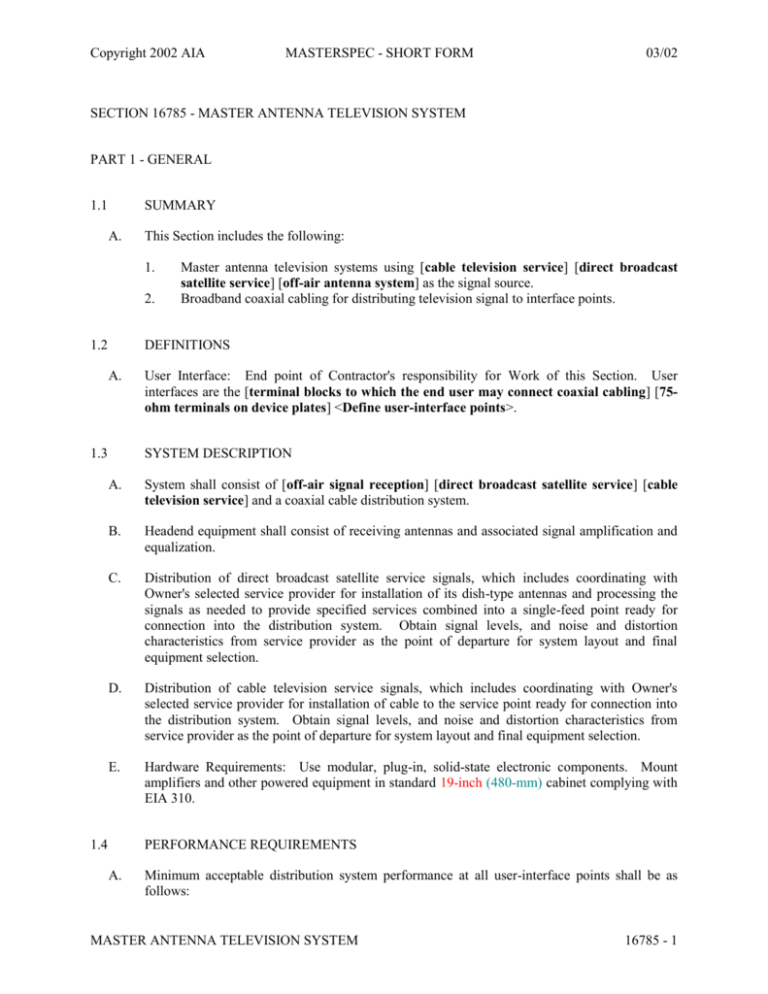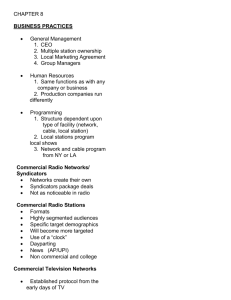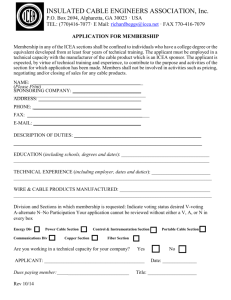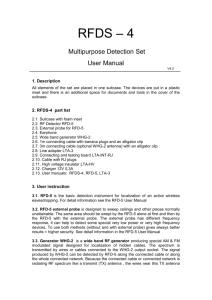16785SF_
advertisement

Copyright 2002 AIA MASTERSPEC - SHORT FORM 03/02 SECTION 16785 - MASTER ANTENNA TELEVISION SYSTEM PART 1 - GENERAL 1.1 SUMMARY A. This Section includes the following: 1. 2. 1.2 Master antenna television systems using [cable television service] [direct broadcast satellite service] [off-air antenna system] as the signal source. Broadband coaxial cabling for distributing television signal to interface points. DEFINITIONS A. 1.3 User Interface: End point of Contractor's responsibility for Work of this Section. User interfaces are the [terminal blocks to which the end user may connect coaxial cabling] [75ohm terminals on device plates] <Define user-interface points>. SYSTEM DESCRIPTION A. System shall consist of [off-air signal reception] [direct broadcast satellite service] [cable television service] and a coaxial cable distribution system. B. Headend equipment shall consist of receiving antennas and associated signal amplification and equalization. C. Distribution of direct broadcast satellite service signals, which includes coordinating with Owner's selected service provider for installation of its dish-type antennas and processing the signals as needed to provide specified services combined into a single-feed point ready for connection into the distribution system. Obtain signal levels, and noise and distortion characteristics from service provider as the point of departure for system layout and final equipment selection. D. Distribution of cable television service signals, which includes coordinating with Owner's selected service provider for installation of cable to the service point ready for connection into the distribution system. Obtain signal levels, and noise and distortion characteristics from service provider as the point of departure for system layout and final equipment selection. E. Hardware Requirements: Use modular, plug-in, solid-state electronic components. Mount amplifiers and other powered equipment in standard 19-inch (480-mm) cabinet complying with EIA 310. 1.4 PERFORMANCE REQUIREMENTS A. Minimum acceptable distribution system performance at all user-interface points shall be as follows: MASTER ANTENNA TELEVISION SYSTEM 16785 - 1 Copyright 2002 AIA 1. 2. 3. 4. 5. 6. 7. 8. 9. 10. 1.5 MASTERSPEC - SHORT FORM 03/02 RF Video Carrier Level: Between 3 and 12 dBmV. Relative Video Carrier Level: Within 3 dB to adjacent channel. Carrier Level Stability, Short Term: Level shall not change more than 0.5 dB during a 60-minute period. Carrier Level Stability, Long Term: Level shall not change more than 2 dB during a 24hour period. Channel Frequency Response: Across any 6-MHz channel in 54- to 220-MHz frequency range, referenced to video carrier, signal amplitude shall be plus or minus 1 dB, maximum. Carrier-to-Noise Ratio: 45 dB or more. RF Visual Signal-to-Noise Ratio: 43 dB or more. RF FM Carrier Level: 13 to 17 dB below video carrier level. FM Frequency Response: More than the 88- to 108-MHz frequency range, signal amplitude is plus or minus 0.75 dB, maximum. FM Carrier-to-Noise Ratio: More than 24 dB. SUBMITTALS A. Product Data: For each type of product indicated. B. Shop Drawings: Show fabrication and installation details for television equipment. 1. 2. Include plans, elevations, sections, details, and attachments to other work. For coaxial cable, include the following installation data for each type used: a. b. c. 3. 4. Nominal OD. Minimum bending radius. Maximum pulling tension. Wiring diagrams. Design Calculations: For signal attenuation budget, line and equipment losses, and signal strength from sources to headend input points. C. Equipment list. D. Field quality-control test reports. 1.6 QUALITY ASSURANCE A. Electrical Components, Devices, and Accessories: Listed and labeled as defined in NFPA 70, Article 100, by a testing agency acceptable to authorities having jurisdiction, and marked for intended use. B. Comply with NECA 1. C. Comply with NFPA 70. MASTER ANTENNA TELEVISION SYSTEM 16785 - 2 Copyright 2002 AIA 1.7 MASTERSPEC - SHORT FORM 03/02 PROJECT CONDITIONS A. Environmental Conditions: 1. 2. 3. 1.8 Interior, Controlled Environment: System components, except central-station control unit, installed in [air-conditioned] [temperature-controlled] interior environments shall be rated for continuous operation in ambient conditions of [36 to 122 deg F (2 to 50 deg C)] <Insert temperature range> dry bulb and 20 to 90 percent relative humidity, noncondensing. NEMA 250, Type 1 enclosures. Interior, Uncontrolled Environment: System components installed in non-[airconditioned] [temperature-controlled] interior environments shall be rated for continuous operation in ambient conditions of [0 to 122 deg F (minus 18 to plus 50 deg C)] <Insert temperature range> dry bulb and 20 to 90 percent relative humidity, noncondensing. NEMA 250, Type [3R] [4] [12] [12K] enclosures. Exterior Environment: System components installed in locations exposed to weather shall be rated for continuous operation in ambient conditions of [minus 30 to plus 122 deg F (minus 34 to plus 50 deg C)] <Insert temperature range> dry bulb and 20 to 90 percent relative humidity, condensing. Rate for continuous operation when exposed to rain as specified in NEMA 250, winds up to [85 mph (137 km/h)] [and snow cover up to 24 inches (610 mm) thick]. NEMA 250, Type [3] [3R] [3S] [4] [4X] enclosures. EXTRA MATERIALS A. Furnish extra materials described below, before installation begins, that match products installed and that are packaged with protective covering for storage and identified with labels describing contents. Provide no fewer than one of each item listed below. Deliver extra materials to Owner. 1. Fuses: One for every 10; each type and rating. PART 2 - PRODUCTS 2.1 MANUFACTURERS A. In other Part 2 articles where titles below introduce lists, the following requirements apply to product selection: 1. 2. 2.2 Available Manufacturers: Subject to compliance with requirements, manufacturers offering products that may be incorporated into the Work include, but are not limited to, manufacturers specified. Manufacturers: Subject to compliance with requirements, provide products by one of the manufacturers specified. SYSTEMS REQUIREMENTS A. Components: Modular plug-in, heavy-duty, industrial- or commercial-grade units. B. Equipment: Silicon-based, solid-state, integrated circuit devices. MASTER ANTENNA TELEVISION SYSTEM 16785 - 3 Copyright 2002 AIA MASTERSPEC - SHORT FORM 03/02 C. Power Supply Characteristics: Devices shall be within specified parameters for ac supply voltages within the range of 105 to 130 V. D. Protect signal cables and connected components against transient-voltage surges by suppressors and absorbers designed specifically for the purpose. Comply with Division 16 Section "Transient Voltage Suppression." E. Provide ac-powered equipment with integral surge suppressors, complying with UL 1449. F. RF and Video Impedance Matching: Signal-handling components, including connecting cable, shall have end-to-end impedance-matched signal paths. Match and balance devices used at connections where it is impossible to avoid impedance mismatch or mismatch of balanced circuits to unbalanced circuits. 2.3 MATV EQUIPMENT A. Description: Signal-source components, signal-processing and amplifying equipment, distribution components, and interconnecting wiring. System shall receive signals from sources, amplify and process them, and distribute them to outlets for receiving sets. Equipment shall translate UHF channels to VHF channels before distribution to outlets. B. Identification of Signal Sources and Channels Distributed: 1. <Insert signal source and basic channel selection.> C. MATV System Qualitative Performance Requirements: Reception quality of color-television program transmissions at each system outlet from each designated channel and source shall be equal to or superior than that obtained with performance checks specified in Part 3 "Field Quality Control" Article, using a standard, commercial, cable-ready, color-television receiver. D. MATV System Quantitative Performance Requirements: Level and quality of signal at each outlet from each designated channel and source shall comply with Specifications below when tested according to 47 CFR 76. 2.4 OFF-AIR ANTENNAS A. [Available ]Manufacturers: 1. 2. 3. 4. 5. Channel Master, Inc. RadioShack Corporation. Terk Technologies. Winegard Company. <Insert manufacturer's name.> B. Antennas shall be tested, marked, and packaged, complying with EIA 774, EIA CEB 6, and EIA CEB 7. Antennas shall be labeled complying with CEA antenna mapping program. C. Off-Air, Mast-Mounted Antennas: Weatherproof single-channel or broadband type, constructed of high-strength anodized aluminum and rated to survive in a 100-mph (160-km/h) wind, minimum. MASTER ANTENNA TELEVISION SYSTEM 16785 - 4 Copyright 2002 AIA 1. 2. D. 03/02 CEA Reception Patterns: <Insert reception pattern and number of antennas>. FM Antenna: Separate from the broadband antenna and [omnidirectional] [directional] type, with 2-dB minimum gain. Antenna-Supporting Structures: Prefabricated, hot-dip galvanized-steel units. 1. 2. 3. 2.5 MASTERSPEC - SHORT FORM Strength of Structure and Attachments: Adequate to withstand 100-mph (160-km/h) winds while supporting installed antennas. Comply with 47 CFR 17 and TIA/EIA 222. Comply with FAA AC 70/7460-1. MATV HEADEND COMPONENTS A. [Available ]Manufacturers: 1. 2. 3. 4. 5. 6. 7. 8. B. Blonder Tongue Laboratories, Inc. Canare Corporation of America. Channel Master, Inc. Leviton Voice & Data Division. Motorola Broadband Communications Sector. Quality RF Services, Inc. Scientific-Atlanta, Inc. <Insert manufacturer's name.> Headend Equipment: [Channel mixers, processors for channel translation] [Broadband amplifier] [Single-channel amplifiers] [Combining networks] for receiving off-air television and FM signals and outputting the signals to cable distribution system. Equip coaxial down leads of the off-air antennas with preamplifiers to send signals at strength required by headend. Headend component performance specified in this Article is minimum acceptable; better performance may be required to meet minimum acceptable system performance standard in Part 1. 1. House units in standard 19-inch (483-mm) electronic equipment cabinet complying with EIA 310. C. Antenna Combiner: Directional coupler design network, combining up to eight antenna signals into a single output. Frequency response of the device shall be 5 to 400 MHz, and the insertion loss between input ports shall be not less than 40 dB. D. Down-Lead Preamplifiers: Antenna mast-mounted preamplifier designed to boost antenna signal, contained in weatherproof housing, single-channel or broadband type. Install power supplies indoors at headend equipment, connected through power inserters to provide power to preamplifiers through the coaxial down-lead cable. 1. 2. 3. E. Frequency Response: Plus or minus 0.75 dB. Minimum Input: Minus 20 dBmV. Return Loss: 14 dB. Channel Mixers: Use for nonadjacent channels only. MASTER ANTENNA TELEVISION SYSTEM 16785 - 5 Copyright 2002 AIA 1. 2. 3. F. 9. 10. 11. Bandwidth: 6 MHz. Return Loss: 16 dB, within the 6-MHz bandwidth. Noise: Not more than 10 dB at maximum gain. Input Level Range, VHF: Minus 20 to plus 30 dBmV. Input Level Range, UHF: Minus 20 to plus 25 dBmV. Output Level Range: 50 to 60 dBmV. Carrier-to-Noise Ratio: Minus 57 dB at plus 10-dBmV input. Automatic Gain Control: Plus or minus 1-dB output variation for rated input level range variation. Frequency Stability: Plus or minus 10 KHz over the operational temperature range. Spurious Output: 60 dB below the video carrier with video carrier output level at plus 60 dBmV and audio carrier level at plus 45 dBmV. Adjacent Channel Rejection: Not less than 60 dB. Frequency Range: [54 to 108, 174 to 220] [54 to 220] MHz. Frequency Response: Plus or minus 1.0 dB across passband. Maximum Noise: 10 dB. Minimum Return Loss: 16 dB. Single-Channel Amplifiers: 1. 2. 3. 4. 5. 6. 7. I. Insertion Loss (Maximum 54 to 216 MHz): 2.5 dB. Return Loss: 14 dB. Out-of-Band Rejection: 12 dB. Broadband Amplifier: 1. 2. 3. 4. H. 03/02 Processors: One for each channel to be translated. 1. 2. 3. 4. 5. 6. 7. 8. G. MASTERSPEC - SHORT FORM Frequency Range: 6 MHz for specified channel. Frequency response: Plus or minus 0.5 dB. Minimum Return Loss: 14 dB. Maximum Noise: 10 dB. Automatic Gain Control: Plus or minus 1-dB output variation for rated input level range variation. Skirt Rejection: Minus 26 dB at plus or minus 5 MHz from channel center. Sound Trap: Adjustable to 10 VdB of attenuation of the sound carrier. FM Module: One RF processor module for each station listed. 1. 2. 3. 4. 5. 6. 7. 8. 9. Frequency: Between 88 to 108 MHz. Output Level: 52 dBmV. Output Level Control: Plus or minus 10 dB. Stability: 0.005 percent, crystal controlled. Sensitivity: 3 mV for 30-dB quieting. Input Level: 60 mV, stereo. Image Rejection: 901 dB. Passband: 200 kHz. Selectivity: Plus or minus 150 kHz or less, at 30 dB down. Plus or minus 250 kHz or less, at 50 dB down. MASTER ANTENNA TELEVISION SYSTEM 16785 - 6 Copyright 2002 AIA J. 03/02 Combining network (mixer) shall be used to combine the off-air TV [FM] [and] [CATV] signals into a single-broadband output. With an output test point, 75-ohm television jack, mixer output step attenuator dual-pilot insertion network, and a removable mixer-to-trunk jumper. 1. 2. 3. 4. Passband: As required by system performance. Distortion: Not more than plus or minus 0.1 dB over any 6-MHz segment. Distortion: Not more than plus or minus 0.5 dB over the 54- to 216-MHz frequency range. Nominal Insertion Loss: a. b. c. 5. 2.6 MASTERSPEC - SHORT FORM 15 dB maximum, channel input to single-system output. 13 dB maximum, channel input to mixer output. 20 dB maximum at test point, e.g., loss from trunk output. Isolation between any Two Inputs: 30 dB. DISTRIBUTION COMPONENTS A. [Available ]Manufacturers: 1. 2. 3. 4. 5. 6. Canare Corporation of America. Leviton Voice & Data Division. Motorola Broadband Communications Sector. Quality RF Services, Inc. Scientific-Atlanta, Inc. <Insert manufacturer's name.> B. Distribution components shall be for signal processing and distribution downstream from headend equipment. C. Signal Power Splitters and Isolation Taps: Metal-enclosed directional couplers with brass connector parts. Where installed in signal circuits used to supply cable-powered amplifiers, power throughput capacity shall exceed load by at least 25 percent. 1. 2. 3. 4. 5. Return Loss: 17 dB. RFI Shielding: 100 dB. Isolation: 25 dB. Impedance: 75 ohms for input and output terminals. Electrically powered components shall be UL labeled. D. Distribution System Amplifiers: Powered by coaxial cable system, equipped with surge protection device and external test points to allow convenient signal monitoring. E. Cable System Power Supplies: Plug-in modular construction, with surge, short circuit, and overload protection. F. Signal Traps: Packaged filters tuned to interference frequencies encountered in Project. G. Attenuators: Passive, of fixed value, used to balance signal levels. MASTER ANTENNA TELEVISION SYSTEM 16785 - 7 Copyright 2002 AIA MASTERSPEC - SHORT FORM 03/02 H. Terminating Resistors: Enclosed units rated 0.5 W and matched for coaxial impedance. I. User-Interface Device: Flush, female-type outlets, designed to mimic power duplex outlet, for mounting in standard outlet box, with metallic parts of anodized brass, beryllium copper, or phosphor bronze. Cable connector mounting shall be semirecessed so its protrusion is flush with the plane of device plate.[ Feedthrough-type cable connection shall not be used] [, except in area housing a single tenant] [, except within a single-dwelling unit]. 1. 2. 3. 4. 2.7 Cable Connector: Female, Type F. Wall Plates: Match materials and finish of power outlets in same space. Attenuation: Less than 0.1 dB. Voltage Standing-Wave Ratio: Less than 1.15 to 1. CABLES A. Cable Characteristics: Broadband type, recommended by cable manufacturer specifically for broadband MATV applications. Coaxial cable and accessories shall have 75-ohm nominal impedance with a return loss of 20 dB minimum from 7 to 806 MHz, and shall be listed to comply with NFPA 70, Articles 810 and 820. B. RG-11/U, Outdoor Antenna Lead-In Cable: No. 14 AWG, solid, copper-covered steel conductor; gas-injected foam-PE insulation. Double shielded with 100 percent aluminum polyester tape, and 60 percent aluminum braid. Jacketed with sunlight-resistant black PVC or PE. Suitable for outdoor installations in ambient temperatures ranging from minus 40 to plus 85 deg C; NFPA 70, Type CATV. C. RG59/U, Indoor Headend Cable: No. 20 AWG, solid, silver-plated, copper-covered steel conductor; gas-injected foam-PE insulation. Triple shielded with 100 percent aluminum polyester tape, 95 percent aluminum braid; covered by aluminum foil with grounding strip. Color-coded PVC jacket. NFPA 70, Type CATVR. D. RG-6/U, Indoor Riser Cable: No. 16 AWG, solid, copper-covered steel conductor; gas-injected foam-PE insulation. Double shielded with 100 percent aluminum-foil shield, 60 percent aluminum braid. Jacketed with black PVC or PE. Suitable for indoor installations; NFPA 70, Type CATV or CM. E. RG59/U, Indoor Distribution Cable: No. 20 AWG, solid, copper-covered steel conductor; gasinjected foam-PE insulation. Double shielded with 100 percent aluminum polyester tape, 40 percent aluminum braid. PVC jacket. NFPA 70, Type CATV. F. RG59/U, Plenum-Rated Indoor Distribution Cable: No. 20 AWG, solid, copper-covered steel conductor; foam fluorinated ethylene propylene insulation. Double shielded with 100 percent aluminum-foil shield, 65 percent aluminum braid. Copolymer jacket. NFPA 70, Type CATV and UL 910. 2.8 CABLE CONNECTORS A. MATV Coaxial Cable Connectors: Type F, 75 ohms. MASTER ANTENNA TELEVISION SYSTEM 16785 - 8 Copyright 2002 AIA B. MASTERSPEC - SHORT FORM 03/02 Patch Panels: Standard electrical enclosures, with NEMA 250 type suitable for environmental conditions at the installed location, with bulkheads and Type F connectors for splicing and patching coaxial cable. PART 3 - EXECUTION 3.1 INSTALLATION A. Install signal line surge suppressors on coaxial cables entering headend equipment space and at antenna mounted amplifiers. Comply with Division 16 Section "Transient Voltage Suppression." B. Support and anchor antenna towers, masts, and mountings. 1. 2. 3.2 Concrete Foundations: Reinforced concrete complying with Division 3 Section "Cast-inPlace Concrete." Steel Anchorage Components: Galvanized-steel shapes and plates complying with Division 5 Section "Structural Steel." GENERAL WIRING A. Wiring Method: Install cables in raceways except in accessible indoor ceiling spaces, attics,[ in hollow gypsum-board partitions,] and as otherwise indicated. Conceal raceways and wiring except in unfinished spaces. B. Wiring Method: possible. C. Splices, Taps, and Terminations: For power and control wiring, use numbered terminal strips in junction, pull, and outlet boxes; terminal cabinets; and equipment enclosures. D. Grounding: According to recommendations in IEEE 142 and IEEE 1100. 3.3 Install cables concealed in accessible ceilings, walls, and floors where COAXIAL CABLE INSTALLATION A. Cold-Weather Installation: Bring cable to room temperature before dereeling. Heat lamps may not be used for heating. B. Cable may not be installed in same raceway with power cable. C. Coaxial cable shall not be spliced except on plywood backboards in wire closets, or in cabinets designated for the purpose. D. Outdoor connections shall be installed in enclosures meeting NEMA 250, Type 4X. Connectors shall be corrosion resistant with properly designed O-rings to keep out moisture. E. Do not use water-based cable pulling lubricants with PVC-jacketed cable. MASTER ANTENNA TELEVISION SYSTEM 16785 - 9 Copyright 2002 AIA MASTERSPEC - SHORT FORM 03/02 F. Do not exceed manufacturer's recommended minimum bending radiuses. G. Attach antenna lead-in cable to support structure at intervals not exceeding 3 feet (1 m). H. Pulling Cable: Do not exceed manufacturer's recommended pulling tensions. Do not install bruised, kinked, scored, deformed, or abraded cable. Do not splice cable between termination, tap, or junction points. Remove and discard cable if damaged during installation and replace it with new cable. I. Cable Support: Install supports at intervals recommended in writing by cable manufacturer. Install supports within 6 inches (150 mm) of connector so no weight of cable is carried by connector. Use no staples or wire ties, pull tie-wrap snug, and do not over tighten. J. Signal Equalization: Where system performance may be degraded in certain operating modes, revise component connections and install distribution amplifiers and attenuators as required, providing a balanced signal across the system. K. Install passive circuit devices, such as splitters and attenuators, in wire closets or cabinets. Do not install attenuators as part of user-interface device outlets. 3.4 ANTENNA AND HEADEND INSTALLATION A. Mount headend equipment in electronic equipment cabinets. B. Parts that require periodic service or maintenance shall be readily accessible. Headend components that require tuning adjustments shall be accessible from the front of equipment cabinets. C. Align antenna elements to achieve maximum signal level and quality. D. Antenna-Supporting Structure: Increase antenna height as required to obtain signal strength needed for specified system performance. 1. E. 3.5 Grounding: As a minimum, comply with NFPA 780, "Installation of Lightning Protection Systems." Antenna Cable Entrance: building envelope. Use entrance fittings, seal, and waterproof penetrations of the IDENTIFICATION A. 3.6 Identify system components, wiring, cabling, and terminals according to Division 16 Section "[Basic Electrical Materials and Methods] [Electrical Identification]." FIELD QUALITY CONTROL A. Manufacturer's Field Service: Engage a factory-authorized service representative to inspect[, test, and adjust] field-assembled components and equipment installation, including connections[, and to assist in field testing]. Report results in writing. MASTER ANTENNA TELEVISION SYSTEM 16785 - 10 Copyright 2002 AIA B. MASTERSPEC - SHORT FORM 03/02 Pretesting: Align and adjust system and pretest components, wiring, and functions to verify that they comply with specified requirements. Replace malfunctioning or damaged items. Retest until satisfactory performance and conditions are achieved. Prepare television equipment for acceptance and operational testing as follows: 1. 2. 3. 4. 5. Use an agile receiver and signal strength meter or spectrum analyzer for testing. Off-Air, Mast-Mounted Antenna Sources: Connect receiver to the down lead of a 10element, single-channel antenna, tuned and oriented to optimize reception for the channel and placed at system antenna's location. Alternatively, connect receiver to a singlechannel video amplifier connected to the down lead of the above single-channel antenna. CATV Sources: Connect receiver to an agile demodulator or CATV set-top converter at CATV service entrance to the facility. Satellite Earth-Station System Sources: Adapt receiver to the output of satellite-TV receiver. CCTV Sources: Connect receiver to the output of each CCTV signal source or the distribution amplifier associated with it. C. Test Schedule: Schedule tests after pretesting has successfully been completed and system has been in normal functional operation for at least 14 days. Provide a minimum of 10 days' notice of test schedule. D. Operational Tests: Perform operational system tests to verify that system complies with Specifications. Include all modes of system operation. Test equipment for proper operation in all functional modes. E. Distribution System Acceptance Tests: 1. 2. Field-Strength Instrument: Rated for minus 40-dBmV measuring sensitivity and a frequency range of 54 to 812 MHz, minimum. Provide documentation of recent calibration against recognized standards. Signal Level and Picture Quality: Use a field-strength meter or spectrum analyzer, and a standard TV receiver to measure signal levels and check picture quality at [all] [random sampling of 25 percent of outlets] <Insert number or percentage>. User-interface outlets. a. b. c. d. 3. F. Test the signal strength in dBmV at 55[, 151, 547,] and 750 MHz. Minimum acceptable signal level is 0 dBmV (1000 mV). Maximum acceptable signal level over the entire bandwidth is 15 dBmV. Television receiver shall show no evidence of cross-channel intermodulation, ghost images, or beat interference. Signal-to-Noise-Ratio Test: Use a field-strength meter to make a sequence of measurements at the output of the last distribution amplifier or of another agreed-on location in system. With system operating at normal levels, tune meter to the picture carrier frequency of each of the designated channels in turn and record the level. With signal removed and input to corresponding headend amplifier terminated at 75 ohms, measure the level of noise at same tuning settings. With meter correction factor added to last readings, differences from first set must not be less than 45 dB. Qualitative and Quantitative Performance Tests: Demonstrate reception quality of colortelevision program transmissions at each user interface from each designated channel and MASTER ANTENNA TELEVISION SYSTEM 16785 - 11 Copyright 2002 AIA MASTERSPEC - SHORT FORM 03/02 source. Quality shall be equal to or superior than that obtained with performance checks specified below, using a standard, commercial, cable-ready, color-television receiver. Level and quality of signal at each outlet and from each designated channel and source shall comply with the following Specifications when tested according to 47 CFR 76: 1. 2. 3. 4. 5. 6. 7. 8. 9. 10. RF video-carrier level. Relative video-carrier level. Carrier level stability, 60-minute and 24-hour periods. Broadband frequency response. Channel frequency response. Carrier-to-noise ratio. RF visual signal-to-noise ratio. RF FM carrier level. FM frequency response. FM carrier-to-noise ratio. END OF SECTION 16785 MASTER ANTENNA TELEVISION SYSTEM 16785 - 12








